I have a favorite take on the façade of the cathedral in Florence, which I turned into a Tuscan Traveler’s Tale. After reading the post, my father asked for the story on Giotto’s bell tower. (Note to father: I won’t be writing a piece on the dome, so please read the National Geographic article, Mystery of Florence’s Cathedral Dome May Be Solved by Tom Mueller, that just came out and pay special attention to the video embedded in it.)
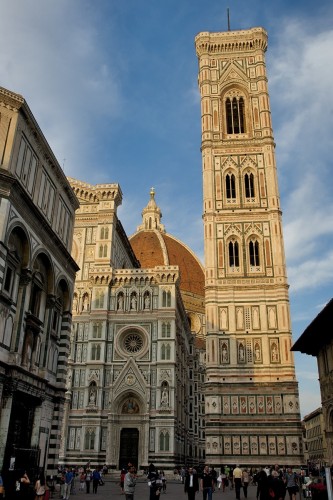
Of course I had a take on the bell tower, too. It went something like this: The Florentines chose Giotto to design the bell tower because he was the most famous artist at the time (circa 1330). Giotto was a fresco painter, not a bell tower builder, so they gave him a good contractor and said “go for it.” Giotto died before the first layer was finished, so a guy named Pisano was hired. He almost finished the next layer with the sculpture-containing niches when he, too, died. Then a man named Talenti was brought in and he lived through the completion of the bell tower, so to be Florence’s bell tower builder wasn’t a completely cursed job.
Now all I had to do was figure out the true story.
As most people know, Giotto’s Campanile (Bell Tower) is a free-standing tower that is part of the complex of buildings that make up the Florence Duomo. Standing adjacent the Basilica of Santa Maria del Fiore and the Baptistry of St. John, the tower is one of the showpieces of the Florentine Gothic architecture with its rich sculptural decorations and the polychrome marble encrustations. This slender structure stands on a square plan with a side of 47.41 feet (14.45 meters). It is 277.9 feet tall (84.7 meters).
The Giotto Groundfloor
On the death in 1302 of Arnolfo di Cambio, the first Master of the Works of the Cathedral, and after an interruption of more than thirty years, a successor was chosen in 1334. The lucky man was the celebrated painter, 67-year-old, Giotto di Bondone. Although he was charged with the entire cathedral building project, Giotto concentrated his energy on the design and construction of a campanile for the cathedral. His design was in harmony with Arnolfo’s polychrome theme for the cathedral.
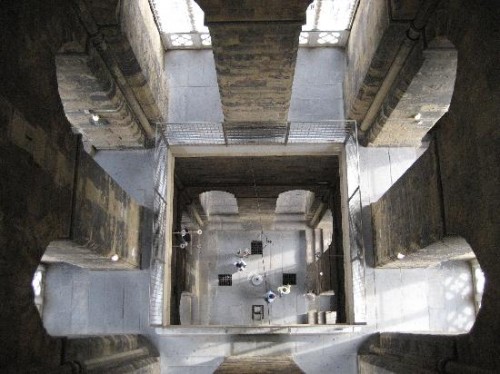
The first stone was laid on 19 July 1334. When Giotto died in 1337, he had only finished the lower floor with its external marble decoration of geometric patterns of white, green and pink marble. His painter’s ethos led him to proceed with the external revestment while the building was going up, thus slowing down its completion. White marble from Carrara, green marble from Prato and light red marble from Siena decorated the surface and a series of hexegonal tiles in relief divided the bottom layer in a classical manner.
This lower floor is decorated on three sides with bas-reliefs in hexagonal panels, seven on each side. When the entrance door was enlarged in 1348, two panels were moved to the empty northern side and only much later, five more panels were commissioned from Luca della Robbia in 1437.
Here is my favorite Giotto tale: Vasari, drawing on a description by Boccaccio, who was a friend of Giotto, says of him that “there was no uglier man in the city of Florence” and indicates that his children were also plain in appearance. Vasari adds a story that Dante visited Giotto while he was painting the Scrovegni Chapel and, seeing the artist’s children underfoot asked how a man who painted such beautiful pictures could create such plain children, to which Giotto, always a wit, replied “I made them in the dark.”
There are a couple of stories that Giotto died of grief for having given the bell tower as he said, “a too small bed for your feet.” It was also rumored that Giotto died of a heart attack because he feared that he designed the base too small to support the weight and the height. In reality, the base of the tower is more narrow than it should be, perhaps to give the effect of greater vertical momentum. But Giotto died at age 70, a ripe old age for the 14th century. (Later designs sustained the height and weight of the tower by constructing four internal polygonal buttresses at the corners.)
The Pisano Part
Andrea Pisano, a goldsmith who learned to sculpt, was famous already for the South Doors of the Baptistery when he succeeded Giotto as Master of the Works in 1343. (Why didn’t the Woolmaker’s Guild, which was charged with paying for the construction, find an architect for the Master of the Works?) Pisano continued the construction of the bell tower, reportedly scrupulously following Giotto’s design, especially for the bas-relief hexagonal panels.
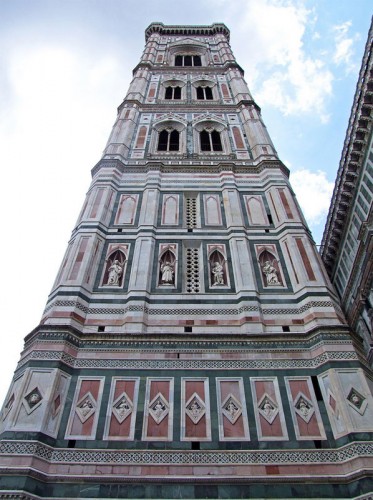
On the tower facade looking toward the Baptistery, the reliefs in the lower row depict the creation of man and woman, the beginnings of human work, and the “inventors” (according to the Bible) of various creative activities: sheep-herding, music, metallurgy, wine-making. In the upper register are the seven planets, beginning with Jupiter at the north corner. On the other facades, in the lower register are depicted astrology, building, medicine, weaving and other technical and scientific endeavors. In the upper registers with diamond- shaped panels are: on the south, the theological and cardinal virtues; on the east, the liberal arts of the Trivium and Quadrivium; to the north, the seven sacraments. (The originals of all these works are in the Museum of the Opera del Duomo.)
Pisano built two more levels, with two rows with four niches on each side and each level, but the niches on the second row are empty and covered in marble. The four statues on the west side were sculpted by Andrea Pisano and date from 1343. These Gothic statues are rather high-reliefs, left unfinished at the back. They represent the Tiburtine Sibyl, David, Solomon and the Erythraean Sibyl.
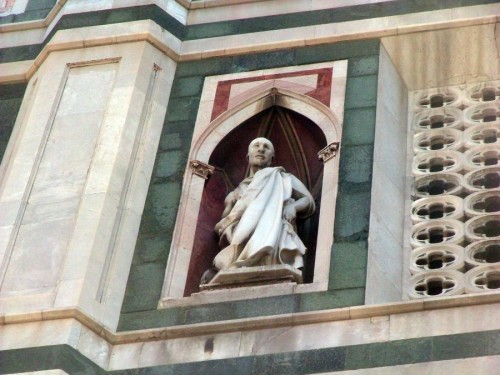
The four Prophets on the south side are already more classical in style and date between 1334 and 1341. The statue of Moses and the fourth statue are attributed to Maso di Banco.
The four Prophets and Patriarchs on the east side date from between 1408 and 1421: the beardless Prophets by Donatello (probably a portrait of his friend, the architect Filippo Brunelleschi), the Bearded Prophet (perhaps by Nanni di Bartolo), Abraham and Isaac (by Donatello and Nanni di Bartolo) and Il Pensatore (the thinker) (by Donatello).
The four statues on the north side were added between 1420 and 1435: Prophet (probably by Nanni di Bartolo, however signed by Donatello), Habacuc (a masterpiece of Donatello, a tormented and emaciated prophet, portraying Giovanni Chiericini, an enemy of the Medicis), which the Florentines called “lo Zuccone” or pumpkin, because of his bald head, Jeremias (by Donatello, portraying Francesco Soderini, another enemy of the Medicis), Abdias (by Nanni di Bartolo).
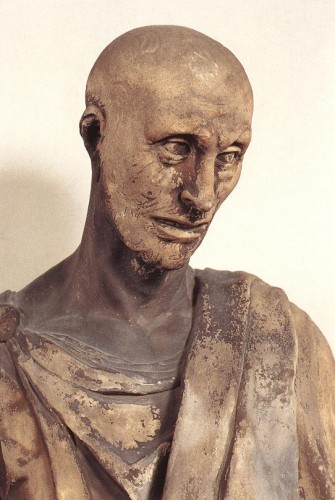
For me, the best attribute of Donatello’s statues is that he knew they would be positioned in high niches so he made them with bowed heads so they would seemingly make eye contact with the passersby down below. (All the statues and hexagonal bas-relief panels on the campanile today are copies. The originals were removed between 1965 and 1967 and are now on display in the Museo dell’Opera del Duomo, behind the cathedral.)
Now, as far as I can tell, Pisano did not die on the job. It seems that he was busy building the bell tower from 1343 until sometime in 1346 when there may have been financial problems that stopped the work on the cathedral site. In 1347, he is listed as the Master of the Works for the cathedral in Orvieto. But in 1348 Pisano disappears. He was 58. The best guess is that he was a victim of the Black Death. Two thirds of Tuscany’s city dwellers died in 1348.
Talenti’s Top
The Black Death, for obvious reasons, slowed work on the Duomo to a standstill for a few years. Francesco Talenti was named the Master of the Works for the Florence cathedral project in 1351. He actually was an architect, as well as a sculptor. He also had worked on the Duomo in Orvieto.
Talenti designed the top layers of the bell tower. Each level is larger than the lower one and extends beyond it in every dimension so that the difference in size counters the effect of perspective. As a result, the top three levels of the tower, when seen from below, look equal in size to the lower levels.
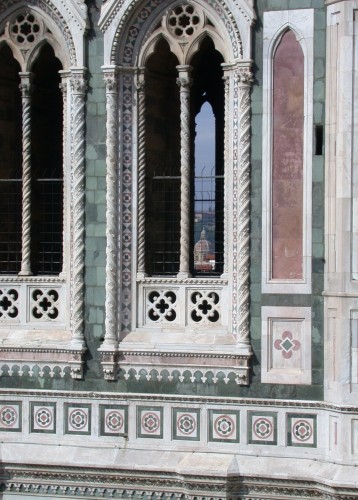
The vertical windows open up the walls in a motif borrowed from the Siena campanile. These pairs of two-light windows (on the third and fourth storys), together with the single three-light window (on the fifth), give the entire structure a delicate and elegant aspect, typical of the Gothic style, but do not suffocate its overall “classical” effect. Instead of a spire, as designed by Giotto, Talenti built a large projecting terrace that not only forms a panoramic roof-top but also substitutes the cusp that was usually found on most Gothic bellowers. This lowered Giotto’s original design height of 400 feet to 277.9 feet. (Giotto was right; it was too tall.)
The top, with its breathtaking panorama of Florence and the surrounding hills, can be reached by climbing 414 steps.
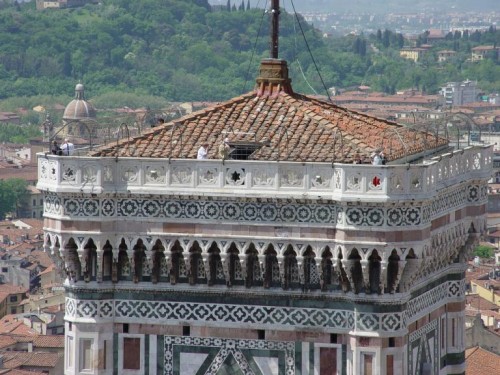
The bell tower was finally finished after twenty-five years of construction in 1359. Reportedly, when Emperor Charles V of Hapsburg saw the bell tower, he said that it was such a precious work of art that it ought to be preserved under glass.
For Bell Fanatics
Since I live in the Duomo neighborhood, I have a love/hate relationship with the bells. Usually I don’t notice them. And then there is the rest of the time.
The original bells:
1) The main bell is named for Santa Reparata and was made in 1475. Damaged, it was recast by Antonio Petri in 1705. It weighs 15,860 lbs.
2) The bell called ‘della Misericordia’. Damaged, it was recast by Carlo Moreni in September of 1830 and weighs 6,414 lbs.
3) The bell called the ‘Apostolica’, fused in April of 1516 by Lodovico di Guglielmo and weighing 5000 lbs.
4) The bell called ‘la Beona’. There is no information as to when or by whom it was cast. Its weight is estimated at 2760 lbs.
5) The bell used for the office of Terce; it bears the name ‘Maria Anna’ and again nothing is known of its history. It weighs 2152 lbs.
6) A small bell cast November 4, 1513, weighing 1400 lbs.
7) The smallest bell, cast in December of 1514 and weighing 1000 lbs.
Total weight: 34,586 lbs.
In 1956-1957, following the replacement of the old wooden armature that supported the bells with a metal structure, and the shift to motor-operated ringing, the Commission appointed to oversee these innovations decided to exclude future use of the five smallest bells, four of which were deposited in the space corresponding to the big windows of Giotto’s Tower, while the fifth – the so-called ‘Apostolica’ – was set on the pavement of the bell cage itself.
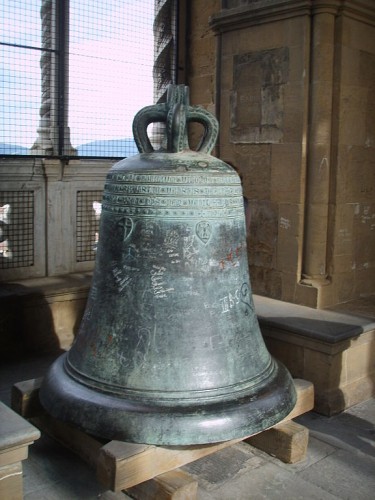
In place of the bells thus ‘pensioned off’, five new ones were cast by the firm of Prospero Barigozzi. These are decorated with bas-reliefs by well-known sculptors, illustrating episodes from Mary’s life and illustrating Marian privileges.
The bells presently in use have the following characteristics:
1) The ‘Campanone’ or ‘Santa Reparata’, of c. 5000 kg. And a diameter of 2.00 m., sounds the note LA;
2) The ‘Misericordia’, of c. 2500 kg., has a diameter of 1,500 m. and sounds DO:
3) The ‘Apostolica’, of c. 1800 kg., sounds RE. It has a diameter of 1.45m. and reliefs by Mario Moschi;
4) The ‘Assunta’, of 846 kg. And a diameter of 1.27m, sounds MI and has reliefs by Bruno Innocenti;
5) The ‘Mater Dei’, of 481 kg., has a diameter of 1.16m. and sounds SOL;
6) The ‘Annunziata’, of 339 kg., sounds LA and has a diameter of 0.95m.
7) The ‘Immacolata’, of 237 kg., sounds SI, has a diameter of 0.75m.
Each of the recast bells bears its own name and, in bas-relief, the arms of Cardinal Archbishop Elia Dalla Costa, who consecrated them in the Baptistery on June 10, 1956. They also bear the emblems of the Opera di Santa Maria del Fiore and of the City of Florence. On the last four there are in addition Latin verses.
The electric motor that controls the ringing of the bells was completely renewed by the Opera di Santa Maria del Fiore in 2000-2001. (Thank goodness for this.)
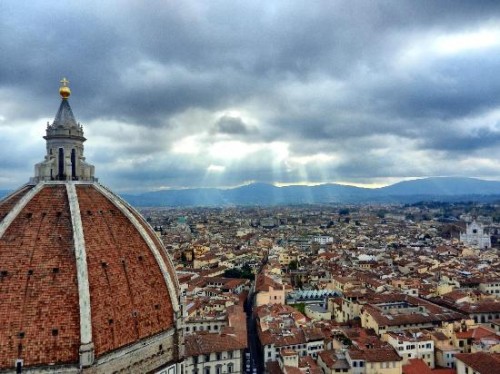
The ancient ringing style, going back to when the bells were four in number, is documented in the fourteenth-century codex, “Mores et consuetudines Ecclesiae florentinae” (to be found in the Riccardiana Library), and varied according to the importance of the religious occasion, just as today:
1) “ut in dominicis” (on Sundays);
2) “ut in ferialibus diebus et in festis III lectionum” (on weekdays and feasts having three readings);
3) “ut in festis IX lectionum” (on feasts with nine readings);
4) “ut in summis solemnitatibus” (on the most important solemn feastdays).
At present several bells are rung together only for liturgical celebrations involving the archbishop or the canons. Bells rung singly indicate, every day, the “Angelus” (at 7AM, noon and at sunset, the penultimate hour of the day according to the ancient canonical way of computing the hours (11PM), which invites all to recite the ‘Credo‘ for the dying, and the first hour of the following liturgical day (one o’clock), which recalls the custom of reciting the ‘Requiem‘ for the dead. A bell is also rung to indicate the suspension of work for the lunch break (11:30AM) and the death of a Guard Captain of the Confraternity of Mercy.
Following tradition, ‘double minors’ are in addition rung for several of the more important devotional moments in the life of the Cathedral: the solemn rosary in the months of May and October, the Stations of the Cross on Fridays in Lent, the Christmas Novena and for other occasions, as the Chapter may determine. The bells are not rung for single daily Masses or for other devotional functions.
In any event, there are plenty of bells heard throughout the day and night in the historic center of Florence.
